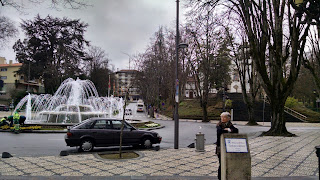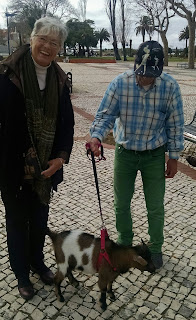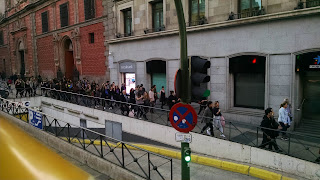On Monday, February 27, we set out to explore eastern and northern Portugal. Our first stop was in Evora - long a favorite city of ours with its dominant castle wall and Roman ruins. We had lunch in what is possibly the worst pastalaria we have ever encountered - just proves that not ALL Portuguese eateries are good. ;-).
Our next stop was Guardia, near the border with Spain about three hours north of Evora. Our hotel, the Vanguardia, is located on a mountaintop. We got a suite - the last available room - for the princely sum of $125 Euros. For that we had two large rooms with a huge bath! It was rainy and very windy so we dined in. Guardia is in Portugal's ski region. Although snow can be elusive, they have Teflon slopes. Ah, the ingenuity!
The next day (February 28) it was still rainy so we didn't walk into town. Instead we continued our drive north to Branganca. This is located in the extreme north east of the country, less than 5 miles from Portugal's northern border with Spain.
We followed the signs to a Pousada - former castles and/or palaces that are now hotels. Unfortunately the restaurant there did not serve lunch, but the very helpful young woman at the desk gave us a suggestion and an address. Before leaving we enjoyed the view.
 |
| View from pousada in Braganca |
Unfortunately we were unable to find the recommended restaurant - even with the excellent GPS in our car. Today was the day before lent (carnival) and everything seemed to be closed. It's a strange feeling when during the lunch hour in a Portuguese city no restaurants are open. We parked the car to wander around this lovely little city and encountered an elderly gentleman who we asked about a possible place to eat. He said, "Just a minute" (in Portuguese, of course), then walked back up the hill he had just descended, checked something out, then came back to tell us about a good restaurant at the top of the hill that was open. Talk about going out of one's way to help strangers!
It seems that although it's not a official holiday, the schools and many businesses were closed. We did see evidence of carnival celebrations from the weekend, so figured everyone had simply given themselves the day off to rest. The proprietor of the restaurant seemed to confirm that theory.
After a nice lunch we wandered back down the hill, found a delightful little store selling regional products where we bought wine and cookies before stepping into the church next door. Although not on the same grand scale as most cathedrals in Portugal - or even in Europe - it was nevertheless an impressive space.
 |
| Impressive interior of the Cathedral in Braganca |
We were really impressed with the beauty of Briganca, but it was time to move on down the road to Viseu - an historic city that dates back to the Visigoths! The route took us through the amazingly beautiful Alto Douro wine region. I do not have the words to describe the beauty of this region! En route we looked up hotels in Viseu and found a Palaceo with great reviews, so I called and booked a room - 69 Euros including breakfast. It's an old palace and located in the historic center of this historic city. We fell in love! Like Briganca, most businesses were closed but we found a nice restaurant less than a block away from the hotel and had a lovely dinner. The next morning we explored Viseu by foot and John thinks he'd like to live here. It is filled with churches, one of which we visited, and ancient buildings. This being Ash Wednesday, we took no pictures inside the church. Even the more modern part of the city is charming with a wonderful square.
 |
| Part of the city center in Viseu |
On our way back to Lisbon we stopped in at Aviero - the Venice of Portugal. Canals run through the city and gondola-shaped boats are ready to carry tourists through them. These boats were originally built to harvest seaweed from the extensive salt marshes that surround the city. Today this is a major destination for beach goers. We had lunch at a nice little restaurant above the fish market appropriately named Mercado Peixe Restaurant. Needless to say, the fish was fresh!
Tourists or not, the buildings in Aviero are spectacular - covered with Azulejo tiles and in excellent condition. At the park next to a canal we met a man with a small goat on a leash.
 |
| Man with a goat! |
 |
| On a canal in Aviero |
 |
Note the lovely building in Aviero.
|
We got back home about 7:00 and walked to our favorite Italian restaurant, DaVinci where we had a light dinner. All in all a nice exploration of parts of Portugal we had not previously visited.
Speaking of Italians, on Sunday we met two visitors from Italy at a pizzeria! We teased them a bit about being from Italy and visiting a pizza place in Lisbon. They said it was to try a different take on pizza - the "white" pizza with a fried egg on top.
Yesterday, March 2, we took the metro to Parque das Nacoes (the Park of Nations) and walked around checking the neighborhood as a possible place to settle more permanently. We stopped in at a real estate office and are now on the list as being potential clients. She has already sent two possible listings. This is a new section of Lisbon developed for the World's Fair hosted here in 1998. In addition to the exposition space - currently hosting an exhibit on King Tut - there is a large mall, an arena for large shows, and the famous Lisbon Oceanarium. We walked along the river, noted the large variety of restaurants and took a gondola ride along the coast above the river. We like the neighborhood and think we would enjoy living here even though it is not what one thinks of when we think of Lisbon. But the Metro ride into the city center is easy, so we would not be that far removed. Who knows!



















